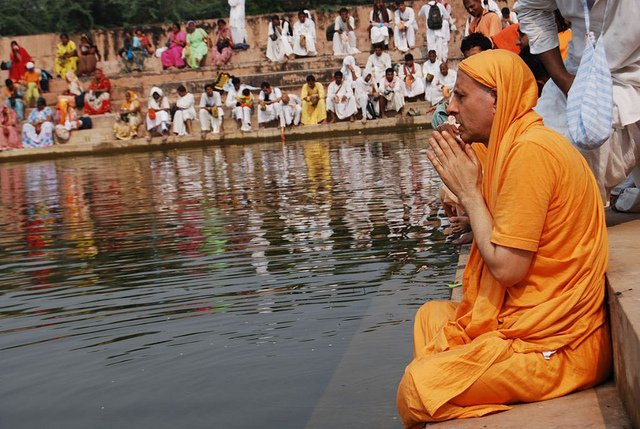
If we are searching for a way to deepen our meditation, chanting is the one thing we might be missing.
The day I was initiated into meditation was also the same day I learned how to chant.
The year was 1992, and it was my first visit to a well-known ashram in Upstate New York.
As we sat in a beautiful white-marbled hall, Swami Chidvilasananda (affectionately known as Gurumayi) led us through 40 minutes of a chant called “Jaya Jaya Shiva Shambo,” meaning hail to Lord Shiva, the bringer of happiness and joy. After the chant died down, she led us straight into meditation.
Although I didn’t realize it at the time, I had received a most powerful gift.
When I got back to Montreal, I was eager to devote my life to meditation, and even perhaps renounce everything and become a swami. The only problem was that I was 19 years old and just beginning my undergraduate career. Still, with adamantine resolve, I woke up each day at 5:30 a.m. to shower and meditate.
Luckily, I took to meditation easily and began experiencing the most wonderful states of peace and bliss. In addition to this newly discovered passion, I faithfully attended the weekly Thursday evening satsang (gathering) at the local meditation center where our primary activity was to chant our hearts out to God.
There are many modes and styles of chanting within the broader Hindu tradition.
Chants can be in any Indian language, although most are in Sanskrit, and are usually devotions to any of the Gods or Goddesses that make up the Hindu pantheon. Styles include bhajans, kirtana or kirtan, and swadhyaya (recitation of scriptures).
I’m generalizing, but in my experience, bhajans tend to be longer, melodic songs, sometimes in call and response style, but often just sung in an ordinary fashion.
Kirtans, on the other hand, are explicitly call and response, and they tend to be limited to two or three phrases that are repeated over and over again. The chants are restricted to a few notes, which gives them their haunting quality, and they can be sung in any of the heart-melting classical Indian ragas, or musical motifs. Some kirtans inspire stillness while others invoke spiritual yearning. Other melodies fill our hearts with gratitude.
Swadhyaya, on the other hand, refers to the recitation, also in Sanskrit, of a scriptural passage or of an entire scripture.
So there I was every Thursday evening, chanting a Sanskrit kirtana with all my heart. Meditation and chanting had become my main practices, and what I didn’t realize was how these two complementing and mutually reinforcing practices would inspire my sadhana, or spiritual practice.
Let me explain.
Although meditation can yield plenty of peace and bliss, the act of meditating still requires a gentle effort to keep our attention on our object of focus (a mantra, in my case). Even in so-called effortless meditations, simply maintaining a refreshed awareness is itself a kind of effort.
For example, in mindfulness meditation, the act of coming back to awareness after our mind is dragged into a thought cannot be done without gently applying our will. That is why I always teach that there is no such thing as a truly effortless meditation.
When we meditate, we are, in effect, gathering our energies unto ourselves like a tortoise gathers its limbs. Although meditation reveals peace and bliss, the daily act of turning our attention away from our thoughts, emotions, and other perceptions creates an austere inner environment.
In this way, meditation is a kind of paradox, because it can be simultaneously overflowing, yet at the same time, austere. As long as our practice is blissful, everything will feel nice, but when we hit the inevitable plateau, our meditation sessions can go from divine to dry in a matter of days.
Whenever we feel stuck or uninspired, we can replenish our heart by experiencing a rush of cathartic emotion. However, the option to bring about those feelings are limited for many yoginis because deep meditation often results in a natural aversion to some of the pleasures and activities we previously enjoyed.
Patañjali, in his Yoga Sutras, discusses one aspect of this in Sutra 2:40, which states: through cleanliness and purity of body and mind, one develops disinterest toward one’s own body, and becomes disinclined toward intercourse with another body.
If we lack the desire to re-energize our batteries through our old social habits, we might find ourselves in a kind of limbo. This is not a bad thing, since there is a specific reason why meditators turn away from old pastimes.
As many of us know, the Tantric tradition prohibits us from indulging in activities that are seen as draining our Shakti, the spiritual energy we draw down in meditation. This can include consuming alcohol and meat, going to bars and clubs, or staying up late (which disrupts our meditation routine). Although people think that Tantra means embracing the senses and enjoying everything life has to offer, in reality, Tantric masters such as Swami Lakshmanjoo lived highly disciplined and austere lives. Chanting bridges this gap by offering a way to engage all our senses and emotions, while at the same time preserving and enhancing our Shakti.
In her article “The Power of Chanting,” Melanie Cooper highlights some of the physical benefits of chanting. We oxygenate our brain, lower our heart rate, and stimulate the production of beneficial hormones.
But beyond the physical, kirtan melodies can be deeply moving, flooding us with love, gratitude, yearning, and even melancholy. The intense emotions that chanting invokes allow us to release tensions and heal.
Beyond the emotional payoff, I’ve found that the vibrations of the Sanskrit words have a profound effect in calming the mind. The vibrations of the Sanskrit phonemes linger long after the chant, allowing our mind to easily sink into meditation the next morning. When we chant, our mind is contemplating the Lord, which attracts grace. In short, chanting is an elixir for both body and soul that acts as a perfect counterweight to the solitary and silent practice of meditation.
So, if you ever find that your enthusiasm for meditation is beginning to wane, try to discover a kirtan that moves you and chant it with all your heart. Chanting is a sure way to rejuvenate a meditation practice that has lost its momentum, and we don’t even have to chant every day.
I used to chant once a week for about an hour and it kept my heart overflowing with love and devotion. Even now, after more than 20 years of practice, I still love to chant to the sublime recordings that Gurumayi made. A tender heart is the surest way into the divine stillness of your own radiant consciousness and nothing softens the heart as the glory of chanting the Lord’s name.
~
Author: Andres Pelenur

No comments:
Post a Comment